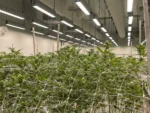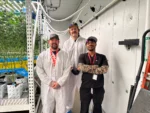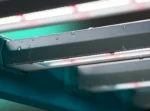For commercial-scale cannabis growers, lighting is a primary driver of plant health, yield, and energy efficiency. Choose the wrong lights, and you’re leaving pounds of potential on the table.
To get to the bottom of what matters, Kenda Branch, BIOS Pre and Post Sales Engineer, breaks down precisely what growers need to know when evaluating commercial LED lighting solutions.
1. Durability: Built for the Grind
Let’s start with the basics: durability.
Your grow room is a high-humidity, particulate-filled, sometimes chaotic environment with water running and temperatures fluctuating. If your lights can’t handle that, you’re already losing.
“When I think of durability for horticulture, I think of what is going to be able to withstand the kinds of environments in these grows more than anything else,” Kenda says.
What to look for:
+ Ingress Protection (IP) Rating: IP65 or higher means your lights can take a hit from dust and water without flinching.
+ Build Materials: Anodized aluminum, corrosion-resistant coatings, and sealed components are important to understand.
2. Spectrum: It’s Not Just Light—It’s Fuel
Yes, cannabis will grow under just about any light. But optimizing the spectrum is like fine-tuning an engine.
“Most things will grow under a variety of different spectrums,” Kenda says. So, growers must know what they want out of the plant.
Tunable-spectrum fixtures are one option, but BIOS prefers to remove those bells and whistles and provide growers with exactly the spectrum they need for their operation.
Here’s the breakdown:
+ Blue Light (400–500 nm): Promotes tight, compact growth—perfect for veg.
+ Red Light (600–700 nm): Drives flowering, but too much can cause photobleaching.
+ Far-Red Light (700–750 nm): Can speed up flowering cycles, but mess with it carefully—it can stretch plants if overused.
3. Transitioning from HPS to LED: Avoid Rookie Mistakes
Still running HPS? You’re not alone, but transitioning to LED isn’t just swapping out bulbs. LEDs behave differently—light distribution, heat output, even how plants transpire under them.
“Five years ago, we definitely saw a huge shift of folks moving from HPS to LED. Most of the people I talk to now are already using LED products,” says Kenda.
What changes:
+ Heat: Less radiant heat means your HVAC system has to pick up the slack.
+ Humidity: Less heat = less transpiration = rethinking your dehumidification strategy.
+ Nutrients: Plants metabolize differently under LED, so you might need to tweak your feed schedule.
Don’t assume your old HPS settings will work. Test, adjust, repeat.
4. Efficiency Metrics: It’s More Than Just Wattage
Energy efficiency equates to dollars in your pocket. If you’re tracking your efficiency, then you’ve got a good sense of how your lights are performing (and how your plants are growing).
“You can have the most efficient light, but if you aren’t utilizing them in your grow properly … it’s not going to matter,” Kenda says.
BIOS can help with that, making sure that your installation and integration go as planned.
Key metrics:
+ PPE (Photosynthetic Photon Efficacy): The gold standard. Look for >2.5 µmol/J.
+ Uniformity: Hot spots and shadows kill yields. Consistent light across the canopy matters.
+ DLI (Daily Light Integral): The total light your plants get in a day. It’s not just about intensity—it’s about the sum of light exposure.
5. Heat Management: Yes, It Still Matters
Switching to LED doesn’t mean heat issues disappear—they just shift.
“You’re especially going to need HVAC considerations when switching from HPS to LED,” Kenda says.
What to watch:
+ Heat Load: LEDs generate less radiant heat, but that can create cold pockets if your HVAC isn’t dialed in.
+ Water/Nutrient Needs: Cooler rooms mean less water uptake, which can throw off nutrient balance.
+ Fixture Design: Some LEDs have active cooling systems—make sure they play nice with your existing setup.
6. Total Cost of Ownership (TCO): Think Long-Term
Growers love to fixate on upfront costs, but the real money is in the long game.
“We tend to fall back on pointing out the seven-year warranty of our products. It matters a lot,” Kenda says.
Consider this:
+ Warranty & Lifespan: Aim for at least a 5- to 7-year warranty. Quality LEDs should run 50,000+ hours without blinking.
+ Maintenance: Cheap lights break. Replacing fixtures mid-cycle isn’t just annoying—it’s expensive.
+ Energy Savings: Higher upfront costs often mean lower operating expenses. Do the math.
7. Planning Ahead: Are You Even Ready to Buy?
This one hits harder than you’d think.
“One thing that people don’t necessarily think is that important is making sure you’re actually ready to buy your lights when you start talking to people,” says Kenda.
Checklist before you click “Buy”:
+ Site Plan: Know your canopy layout, ceiling height, and airflow patterns.
+ Light Plan: Get a photometric layout from the manufacturer. It’s usually free.
+ Weight Load: Some LEDs are heavy. Make sure your infrastructure can handle it.
8. Trends to Watch: Where LED Tech Is Headed
LEDs aren’t standing still. The tech is evolving, and savvy growers are staying ahead.
“Spectrum is definitely something that everybody that I’ve been hearing from is still kind of paying attention to,” says Kenda.
Emerging trends:
+ Reliability and Support: Commercial grow rooms are challenging. Make sure the lights you select will continue to perform over time. And the manufacturer you are working with will be there to support you and your investment.
+ Smart Controls: Automation is king. Look for lights that integrate with your environmental control systems.
+ Higher PPE: Efficiency is creeping higher every year. Don’t get stuck with last-gen tech.
Final Thoughts: It’s Not Just About the Lights
Choosing the right LEDs is simply one point in the broader work of integrating your lighting equipment into your grow—your environment, your strains, and your process.
With lighting, you’re investing in plant health, operational efficiency, and long-term profitability.
Make it count.




